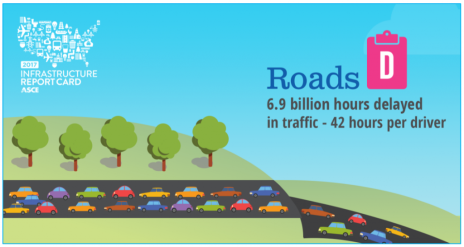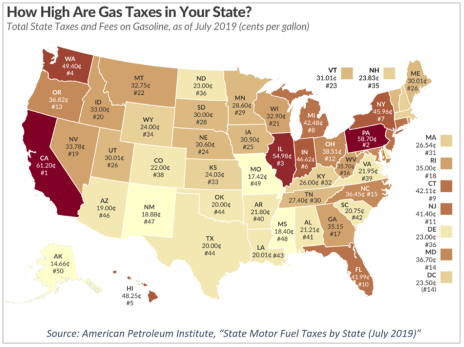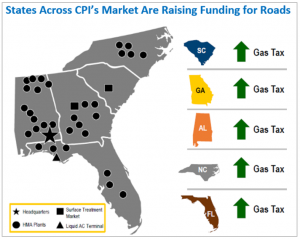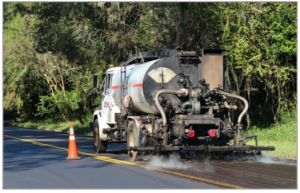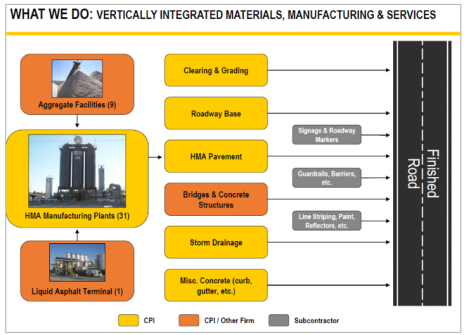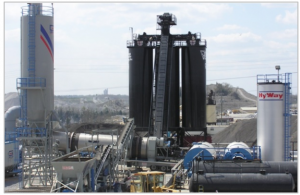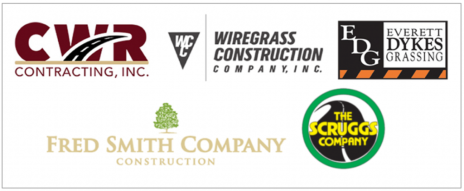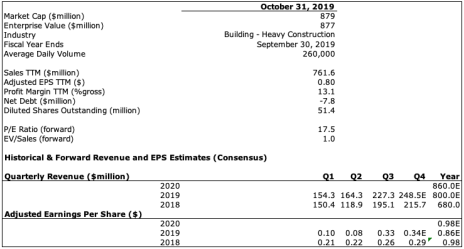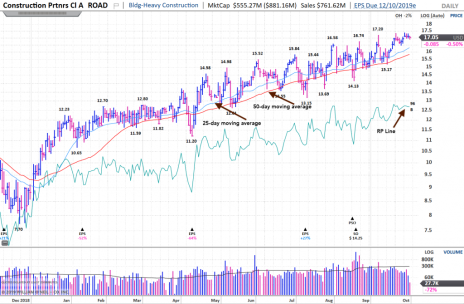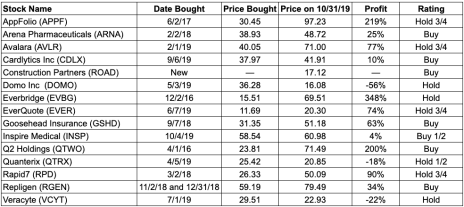This month we’re venturing into the services sector with a stock that fits the Growth at a Reasonable Price (GARP) strategy that’s come back into favor recently. This isn’t a high-flying stock with a new widget or software solution. It’s a pretty basic business really. In all likelihood, it’s insulated from trade wars, and even recessions too.
This little nugget is helping rebuild America’s infrastructure, one road at a time. With funding for road construction and repairs going up, and a long list of acquisition targets to roll into its business, this young company has a bright future.
All the details are inside the November Issue of Cabot Small-Cap Confidential.
Cabot Small Cap Confidential 246
[premium_html_toc post_id="189843"]
THE BIG IDEA
In its 2017 infrastructure report card the American Society of Civil Engineers (ASCE) gave America’s infrastructure a grade of “D+”.
America received the same grade in 2013. That was an improvement over 2009 (and 2005) when we received a “D”.
Suffice to say, there’s room for improvement.
The ASCE looks at 16 different categories of U.S. infrastructure, spanning aviation to energy to ports, roads, bridges and schools. But while there are a lot of areas American can improve, this month’s Issue of Cabot Small-Cap Confidential is specifically about America’s highways, roads, parking lots and bridges.
Our roads have been performing in line with the rest of America’s infrastructure since the 1990s. That is to say, they’ve been getting straight Ds. The glass-half-full perspective is that, where there’s room for improvement, there’s room for an undiscovered growth stock!
Improving our roadways has become a higher priority over the last five years. In 2015 President Obama signed the Fixing America’s Surface Transportation (FAST) Act into law. This was the first federal law in over a decade that provided secure funding to try and rebuild the nation’s deteriorating roads.
The FAST Act authorizes $305 million from 2016 through 2020. It also directs certain funds into the Highway Trust Fund (HTF), which is the funding source for most programs in the Act, to help keep it solvent. The HTF had been hamstrung for years because the federal tax – 18.4 cents on gas and 24.4 cents tax on diesel – has been stagnant since 1993.
While we can’t speculate about what the next administration will do, the evidence shows both parties are intent on improving infrastructure.
Plus, at a state level, Department of Transportations (DoTs) have begun to respond to the crisis by bumping up their own gas and diesel tax rates. That trend has been going on for several years and continues in 2019.
The initiative to fix America’s roads is one of the big-picture trends that’s helping construction and infrastructure stocks move higher. JP Morgan estimates that Vulcan Materials (VMC), the country’s largest producer of construction aggregate, asphalt and ready-mix concrete, will see revenue for highways go up an average of 60% over the next five years across its footprint. That’s a nice tailwind!
Analysts are bullish on stocks with exposure to road construction and resurfacing because funding is going up as both Democratic and Republican administrations recognize that America’s prosperity depends, in part, on safe and functioning roads. It also isn’t lost on big investors that exposure to infrastructure spending could be anti-cyclical, meaning it could be secure even in a recession, regardless of trade risks.
I’ve identified a young, unknown company that’s incredibly well-positioned to capitalize on the trend. I doubt you’ve ever heard of it. As investors look to jump in on the rebuilding of America’s highways, I expect this young company will flourish. Here’s the full story.
THE COMPANY
Construction Partners Inc. (ROAD), also known as CPI, is a vertically integrated pure-play roadway construction and maintenance company operating in the southeast U.S. The company is currently focused on the five states of North Carolina, South Carolina, Georgia, Alabama and Florida, where it covers over 28,500 miles of highway infrastructure.
Based on revenue, industry sources rank it as the 29th-largest heavy contractor, and 138th-largest contractor overall in the U.S.
Annual state DoT budgets imply CPI’s five-state footprint represents a $23 billion market, not including privately funded projects. With projected 2019 revenue of $800 million, the company has only captured a fraction of it.
Within Construction Partners’ market Georgia received the highest ASCE grade, a C+. It’s safe to say there’s a lot of work left for CPI to do. And all the states where CPI is active are raising gas taxes and other funding sources to improve their roads.
Construction Partners works on both public (70% of revenue) and private (30% of revenue) infrastructure projects, including highways, roads, bridges, airports and commercial and residential developments.
It also sells construction materials to third-party customers, including hot mix asphalt (HMA), aggregates, liquid asphalt and ready-mix concrete.
CPI began operations in 2001 with Charles Owens (President and CEO) and Alan Palmer (Executive VP and CFO) leading the charge. Both had prior experience in construction working for Superfos Construction U.S., the North American operations of a publicly held Danish company. During their tenure with Superfos they gained experience with the growth-through-acquisition model that’s helping drive part of CPI’s double-digit growth right now.
The company has received backing from Texas-based majority investor and private equity firm SunTx Capital partners since the early days. It went public in May 2018 and currently has a market cap of $890 million.
Management says it expects to grow organic revenue in the high single digits to low double digits, and add to that through acquisitions, from which it expects to pull out costs while adding scale.
At the end of the day this business should be able to sustain double-digit growth because there’s no end in sight to the roadwork (both new and recurring projects) that needs to be done. There are also numerous acquisition targets – both paving companies and materials plants – that can help CPI build out its materials sourcing network and service area.
THE PRODUCT
What kinds of jobs does CPI do?
Management does not stray out of its sweet spot. This company is not running around trying to do everything under the sun and compete on every bid put out there. It doesn’t go after large, complex mega projects.
Instead, it focuses mainly on roadbuilding and maintenance. These tend to be shorter duration projects that aren’t overly complex. It is typically the prime contractor (meaning it got the job), although in about 30% of cases it will be a subcontractor on a larger project.
As part of its work scope CPI will do all the time sensitive work, including site development, utility and drainage systems, miscellaneous curb and gutter work and concrete and/or hot-mix asphalt (HMA) work. This means it is mostly clearing land, constructing roadway base layers and laying down asphalt.
It often subcontracts out the smaller, less time-sensitive work, including signage, guardrails, line stripping, painting and reflectors.
How is CPI Different from the Competition?
Being vertically integrated means CPI often supplies its own materials from company-owned liquid asphalt terminals, aggregate facilities (sand and gravel), and hot mix asphalt (HMA) plants. Given that there is a set geographic range within which it’s economical to source these materials, having the proper infrastructure is one competitive advantage.
Another source of advantage is scale. CPI isn’t a huge company, but it’s no peanut either. It has 2,000 employees and is active in over 30 markets across five states. That helps it mobilize crews and equipment across markets in ways that smaller companies just can’t compete with.
CPI can be industry leading in terms of efficiency because it does have scale. That helps with all the operations aspects of this type of business, from job estimating and bid vs. actual analysis, to equipment utilization and corporate IT systems.
I’ll be perfectly honest – these aren’t fancy ways to differentiate and compete. This is no high tech company. There’s no new and improved paving equipment or proprietary asphalt mix that makes CPI better than the rest. This is a service company where price, processes, operations, people and reputation matter.
That’s part of why I like it. It’s not overly complicated. And with demand for its services growing and a pipeline of acquisition targets in front of CPI, management should be able to execute on a very steady growth trajectory for many years. That’s been a winning combination for other roll-up type businesses. And I think it will work for CPI too.
Acquisitions: Part of the Hot Mix
This is the perfect type of business to grow through acquisitions. There are a lot of small, family owned road construction and paving companies around. CPI has completed 20 acquisitions, including four since it went public eighteen months ago.
Bigger “bolt on” acquisitions result in an expansion of the families under the CPI umbrella. Smaller “tuck-in” acquisitions are absorbed into one of the larger operating companies that make up CPI. It’s typical for acquired companies’ management teams to come into the CPI family, which is an important factor when company owners consider selling. Construction Partners’ management team believes this has helped make the company the buyer of choice among owners seeking to sell.
Construction Partners currently has five operating companies under the CPI umbrella. They are:
CWR Contracting was CPI’s first acquisition, back in 2001, and has been serving Florida since 1976.
Wiregrass Construction was acquired in 2002 and has been serving Alabama since 1965.
Everett Dykes Grassing is focused on Georgia and South Carolina, was founded in 1968 and acquired in 2011.
Fred Smith Company has been in North Carolina for over 90 years and was acquired in 2011.
The Scruggs Company was acquired in 2018 and has been serving Georgia since 1964.
A few of the more recent tuck-in acquisitions, and rationale for buying, include the following:
February 2019, Hot Mix Asphalt and Ready-Mix Concrete Business – Okeechobee, Florida: Purchased for $8.9 million this acquisition allows CPI to address more geographic areas in the state.
February 2019, Liquid Asphalt Terminal – Panama City, Florida: Purchased for $10.8 million this asset helps CPI receive, store and process liquid asphalt for construction projects.
July 2019, Hot Mix Asphalt Manufacturing Plant & Paving Company – Gadsden, Alabama: Purchased for $5 million this asset includes and aggregates quarry and should create synergies with other operations in Alabama.
October 2019, Mancil’s Tractor Service – Palm City, Florida: This acquisition includes one hot mix asphalt plant, 100 employees and a diverse equipment fleet capable of performing a wide range of services across high-growth areas of Florida’s east coast. Financial terms were not disclosed.
The Business Model
This is a project, people and process management type of company. Most projects are done on a fixed price contract (such as price per ton of asphalt installed) and lump sum contracts (total job includes labor and materials). Profit margins in asphalt and paving work aren’t huge, and jobs often go to the lowest bidder. To repeatedly win and retain talent, Construction Partners needs to be efficient across the board, be reliable, and be timely. On time and on budget is the name of the game.
CPI doesn’t mess with what it does best, which are jobs that aren’t too big and aren’t too small. Management focuses on aspects of the business where it can trim a percent or two of costs. It expects to grow organic revenue in the high single to low double digits, while making step changes thorough acquisitions that are immediately accretive to the bottom line. Investors should expect acquisitions to be financed through low interest debt, cash flow and equity offerings. As the business scales up, costs as a percentage of revenue should decrease.
Construction Partners’ fiscal year ends in September. Quarterly revenue growth tends to be lumpy due to weather and daylight, with roughly 40% coming in the first half of the fiscal year (October – March) and the remaining 60% coming in the second half (April – September). The flip side of this is that backlog tends to build in the first half of the year when jobs are being put out to bid, then decreases in the second half as the company cranks out projects.
The Bottom Line
In fiscal 2018 (ended September 31, 2018) Construction Partners delivered $680 million in revenue, an increase of 20% over FY 2017. Adjusted EPS in 2018 was $0.98, a 92% improvement over 2017.
Through the first nine months of fiscal 2019 revenue is up 18% to $546 million and the company has delivered adjusted EPS of $0.51, down from $0.69 in the same period in 2018. The decrease is mostly due to a $14.8 million settlement that boosted EPS in 2018. Year-to-date, public projects have grown by 20% while private have grown by 12%.
In Q3 revenue was up 17% to $227.3 million. Nearly $11 million of that was due to acquisitions completed in the April – June period. Third-quarter adjusted EPS of $0.33 was a 27% improvement over EPS of $0.26 in Q3 FY 2018. Adjusted EBITDA margin, a measure of profit before taxes, depreciation and amortization, jumped 2.2% to 13.8%. Analysts love to see that margin improvement, especially when it comes from operating efficiencies, as was the case in Q3.
Project backlog at the end of June was $581 million, roughly 38% of which management expected to finish before the end of September. That’s consistent with historical trends. At the end of the quarter the company had $59.7 million in cash and $52 million in long-term debt, giving it a debt to trailing EBITDA ratio of 0.74. That’s not excessive at all.
The company is on pace to deliver revenue of $800 million this year, implying 18% top-line growth. Expected adjusted EPS is $0.86, a 12% decrease that’s misleading because 2018 benefitted from the settlement income. In 2020 analysts see 8% revenue growth (to $860 million) and 14% EPS growth (to $0.98). I expect unannounced acquisitions will ultimately boost 2020 results.
RISK
DoT Revenue Concentration: In the first three quarters of FY 2019 the company derived over 26% of revenue from Alabama and North Carolina Departments of Transportation. This isn’t necessarily bad but does illustrate how damaging it could be if relationships with either of these departments deteriorated.
Related Party Transactions: Much of CPI’s senior management has come together through prior working relationships and/or the acquisition of family-led businesses. There are business relationships that continue to persist now that CPI is public. These are likely to receive more scrutiny than they would when the company was private. Business dealings include subcontracting work (grading and trucking services, etc.), renting vehicles, leasing property, etc. from family member of Senior Vice Presidents. Over the last nine months the total revenue earned through these related party transactions is $1.6 million and total expenses incurred is a little over $11 million. Compared to $546 million in revenue over the same time that’s not a huge deal. But it’s not ideal to have these relationships and we’ve seen short sellers zero in on these types of things in hit pieces. If that happens shares of ROAD could take a hit.
Reduced Public Infrastructure Spending: CPI is largely dependent on federal, state and local government spending. Public projects are funded by these sources and budgets have been stable. Federal funds are allocated on a state-by-state basis, with each state required to match the federal funds contribution. Federal highway funding is mostly derived from the Highway Trust Fund, which is funded from fuel taxes and other user fees. If anything happens that causes these budgets to decrease, such as lack of approval of a new highway funding bill before 2020, CPI’s revenues could take a hit.
High Exposure to Five States: The company’s exposure to just five states in the southeast means it’s exposed to storms and other events that could cause disruption in work schedules.
COMPETITION
CPI competes with multiple companies in all its local markets. That’s just the nature of this business. You can only truck concrete and asphalt so far, so there are a lot of players in what’s a very fragmented industry. It competes with companies that provide the necessary construction materials, like Vulcan Materials and Martin Marietta Materials (MLM), as well as service companies that do the labor. Competitors in different markets may be large, or small, family-owned operations. And they may focus on one type of service and one product, like paving. Or they may do huge mega-projects, like building bridges, blasting bedrock and building highways. Competition is really all over the place.
THE STOCK
Trading Volume: ROAD has a market cap of $887 million and trades an average of 260,000 shares a day. That works out to around $4.5 million worth of the stock trading each day. Big days are 500,000 shares, which has happened eight times over the last six months. Several of those days were in September 2019 when a large investor sold off some shares. Our subscriber group shouldn’t move this stock.
Historical Price: ROAD went public on May 4, 2019 at 12 per share. It briefly rose to 14 then fell and spent most of October through December trading in the 8 to 10 range. It was back above 11 by the end of January and has been steadily making a series of higher highs and higher lows since, with a dip below the 50-day line every now and then. The trading pattern is suggestive of a stock that’s under steady accumulation.
Valuation & Projected Price Target: ROAD currently trades with a forward P/E ratio of 17.5 based on estimated fiscal 2020 adjusted EPS of $0.98. That’s a discount to VMC (2020 P/E of 25) and MLM (2020 P/E of 23.2). Revenue and EPS growth rates for the three companies vary depending on the period but for comparison purposes they’re not in different galaxies. And CPI’s debt-to-trailing EBITDA ration at the end of Q3 was just 0.74, well below the 2.0 – 2.5 ratio of VMC. In short, I think the stock’s valuation could reach into the mid-20s as the story gets out there, implying the stock could easily move up into the 25 range within 12 months. That’s almost 50% above where it is now. Longer term, I see ROAD as having multi-bagger potential.
Buy Range (next two months): I’d prefer to see purchases in the 15.5 to 18.5 range. If the stock continues to trend as it has you should be able to average in with purchases made within those bookends. We could easily see a spike higher or lower too. Provided there’s no negative news, I’d be inclined to hold off on the high spikes and buy on the low ones. If there’s an announcement, such as an acquisition or capital raising event, that changes the growth trajectory or balance sheet I’ll update my rating accordingly.
The Next Event: Management will speak at the Baird Industrial Conference on November 6. ROAD’s Q4 fiscal 2019 ended on September 30 so it will report later than most other companies we follow. Estimates suggest a report date around December 10, 2020.
Construction Partners Inc. (ROAD) Financials
Construction Partners Inc. (ROAD) |
UPDATES ON CURRENT RECOMMENDATIONS
Buy means accumulate shares at or around the current price.
Hold means just that; hold what you have. Don’t buy, or sell, shares.
Sell means the original reasons for buying the stock no longer apply, and I recommend exiting the position.
Sell a Half means it’s time to take partial profits. Sell half (or whatever portion feels right to you) to lock in a gain, and hold on to the rest until another ratings change is issued.
Back On Track
This was the most encouraging week in a long time. On the back of big tech earnings from companies like Microsoft (MSFT), Apple (AAPL), Salesforce.com (CRM), Amazon (AMZN), etc., we’ve seen the broad market hit all-time highs and pockets of growth stocks come back to life.
Concurrently, I’ve seen many strong bounces in good stocks that had previously been taken out to the woodshed in this software correction. Not that these stocks look beautiful or anything right now. But check out Tenable (TENB), Zendesk (ZEN) and Instructure (INST) as just three examples of stocks that look a heck of a lot better after reporting.
The message? Software stocks are likely oversold. I expect significant action in our software names over the next two weeks as they report. I can’t guarantee all moves will be in the right direction. That depends on how companies have executed over the last three months. But provided they have done their jobs and not run into any roadblocks, we should see many of these stocks trading higher a week from now.
At the same time, we have a third rate cut, a flurry of articles and blog posts detailing how well stocks do with three cuts (but not 4!!) and modest optimism on the China-U.S. trade war. That all means a greater sense that there’s potential here for an end-of-year rally in growth. Oh, I almost forgot: GDP was up 1.9%. That’s better than the 1.6% expected. Another modest positive.
The punchline here is we can lean a little more bullish.
As evidenced by this month’s new stock, Construction Partners (ROAD), I am starting to spread my research around a little and see what else we can add to the portfolio beyond software and MedTech. I’m not saying I’m going to stay on that track. But I’m not saying I won’t. It all depends on what looks good as of the first Friday of every month!We have a big week of earnings on tap. Look for the “EVERs”—Everbridge (EVBG) and EverQuote (EVER) – to report on Monday.
We will hear from Rapid7 (RPD), Avalara (AVLR) and Inspire (INSP) on Tuesday. Then on Wednesday the “Qs,” Quanterix (QTRX) and Q2 Holdings (QTWO), step up to the plate. And Arena Pharmaceuticals (ARNA) closes things down on Thursday.
Buckle up!
Changes this week
None
Updates
AppFolio (APPF) reported Monday, beat expectations and the stock popped. We enjoyed a little follow through, and shares are now 11% off all-time highs. Let’s keep holding. HOLD
Earnings: Done
Arena Pharmaceuticals (ARNA) was essentially flat this week despite news that it began dosing patients in the ADVISE phase 2 trial evaluating etrasimod in atopic dermatitis (AD). This wasn’t a huge surprise. Management will issue earnings (not that Arena really has any) next Friday. I’ve had at buy and am keeping there. BUY
Announced earnings date: Tuesday, November 5
Avalara (AVLR) was staging a little rally, until Friday. There’s no news here as management is keeping a lid on things until earnings, which come out on Tuesday. We’re looking for revenue to jump 34% to $93.1 million and for the EPS loss to decline 29% to -$0.10. This should put Avalara on track to grow revenue by 37% in 2019 and deliver an EPS loss of -$0.22. If you want to gamble ahead of earnings my expectation is that Avalara will beat and the stock will jump. Officially, I’ll keep at hold until we see a bit more of an uptrend though. HOLD
Announced earnings date: Tuesday, November 5
Bandwidth (BAND) was sold a few weeks ago. No news. This will be the last mention of the stock unless I decide to add it back to the portfolio. SOLD
Announced earnings date: Wednesday, November 6
Cardlytics (CDLX) hit a new 52-week high near 42 yesterday and looks amazing. Earnings are due out a week from Tuesday. There’s been no news in the past week. Analysts see revenue up 45% to $50.1 million in Q3 while EPS should stay flat at -$0.15. For the full year, revenue is seen rising 27%. BUY
Announced earnings date: Tuesday, November 12
Domo (DOMO) is moving sideways on no news. HOLD
Estimated earnings date: December 6
Everbridge (EVBG) reports Monday and we’ll keep the stock at hold into the event. That said, with shares 33% off their highs and a little more appetite for growth, this one could move. This could be a good place to start buying if you’ve been waiting for a window. For those who have a big gain already and have seen it whittled away somewhat over the past four months, it’s safer just to hold through earnings. Revenue is seen rising 32% in Q3 while EPS loss should be chopped in half, to -$0.05. In 2019, revenue is expected to jump 33% and EPS should be -$0.25. HOLD
Announced earnings date: Monday, November 4
EverQuote (EVER) will also report Monday and my advice is the same as it is for Everbridge: OK to buy a little if you don’t have any and are risk tolerant, but safer to hold through the event if you’re already in the stock and don’t want to risk any more capital. It’s going to be very interesting to see how the new verticals are doing. Analysts see revenue up 40% in Q3 and up 40% in 2019. The company’s still losing money, in part because of investments in the aforementioned new verticals (renters’ insurance, health insurance, etc.). EPS should be -$0.47 this year. HOLD
Announced earnings date: Monday, November 4
Goosehead Insurance (GSHD) reported this morning and will host a conference call at 8:30 am. I sent out a Special Bulletin earlier detailing the results and will follow up with insights from the conference call later. BUY
Earnings: Done
Inspire (INSP) will report on Tuesday. Revenue should be up around 60% this year, with 47% growth (to $19.2 million) expected in Q3. Earnings are seen coming in at -$0.48 in Q3, and -$1.50 for the full year. I’ve had a buy a half rating and am keeping it there. BUY A HALF
Announced earnings date: Tuesday, November 5
Quanterix (QTRX) will report on Wednesday and we’re hoping the event will inject some life back into this stock, which has pulled back mightily from its June high of 36. Analysts see Q3 revenue up 19% and an EPS loss of -$0.46. For the full year revenue is seen up 25%, to $50 million, and an EPS loss of -$1.78 is expected. As I said last week, Quanterix is underfollowed, and management sees revenue growing closer to 40% for the next couple of years! So there’s a little disconnect between consensus estimates and what management has said. It’s a great story, just nobody knows about it (yet). HOLD HALF
Announced earnings date: Wednesday, November 6
Q2 Holdings (QTWO) reports next Wednesday. I’ve had the stock at buy since it’s more than 20% off its highs and I see revenue growth accelerating. With the addition of the commercial lending solution Precision Lender acquired recently (the biggest acquisition in Q2’s history) forward growth estimates should go up. In terms of consensus, revenue is seen up almost 30% this year and 23% in 2020, with EPS dipping this year (to -$0.13) before bouncing back to $0.38 in 2020 (up 192%). On the call we’ll be looking for more insight into Precision and other thoughts from management on broader M&A activities. BUY
Announced earnings date: Wednesday, November 6
Rapid7 (RPD) clawed back to near its October high this week. We’ll get a report on Tuesday. Analysts see revenue up 29% to $80.2 million and EPS of -$0.02. For 2019 look for revenue to climb 33% and for the first year of positive profits (EPS of $0.05 expected). Hold into the event. HOLD
Announced earnings date: Tuesday, November 5
Repligen’s (RGEN) reported yesterday morning and I detailed the report in a Special Bulletin. It was good, and Repligen stays at buy. BUY
Earnings: Done
Veracyte (VCYT) reported last week and was moved to hold after the event given that the stock fell down below 22. The report wasn’t awful, and shares have bounced back a little this week. It should be fine long term, but we don’t have a lot of room to play with here so I’m keeping Veracyte at hold until it gets back into the mid-20s. HOLD
Earnings: Done
Please email me at tyler@cabotwealth.com with any questions or comments about any of our stocks, or anything else on your mind.
The next Cabot Small-Cap Confidential issue is scheduled for December 6, 2019.
Cabot Wealth Network
Publishing independent investment advice since 1970.
CEO & Chief Investment Strategist: Timothy Lutts
President & Publisher: Ed Coburn
176 North Street, PO Box 2049, Salem, MA 01970 USA
800-326-8826 | support@cabotwealth.com | CabotWealth.com
Copyright © 2019. All rights reserved. Copying or electronic transmission of this information is a violation of copyright law. For the protection of our subscribers, copyright violations will result in immediate termination of all subscriptions without refund. No Conflicts: Cabot Wealth Network exists to serve you, our readers. We derive 100% of our revenue, or close to it, from selling subscriptions to its publications. Neither Cabot Wealth Network nor our employees are compensated in any way by the companies whose stocks we recommend or providers of associated financial services. Disclaimer: Sources of information are believed to be reliable but they are not guaranteed to be complete or error-free. Recommendations, opinions or suggestions are given with the understanding that subscribers acting on information assume all risks involved. Buy/Sell Recommendations: All recommendations are made in regular issues or email alerts or updates and posted on the private subscriber web page. Performance: The performance of this portfolio is determined using the midpoint of the high and low on the day following the recommendation. Cabot’s policy is to sell any stock that shows a loss of 20% in a bull market or 15% in a bear market from the original purchase price, calculated using the current closing price. Subscribers should apply loss limits based on their own personal purchase prices.


